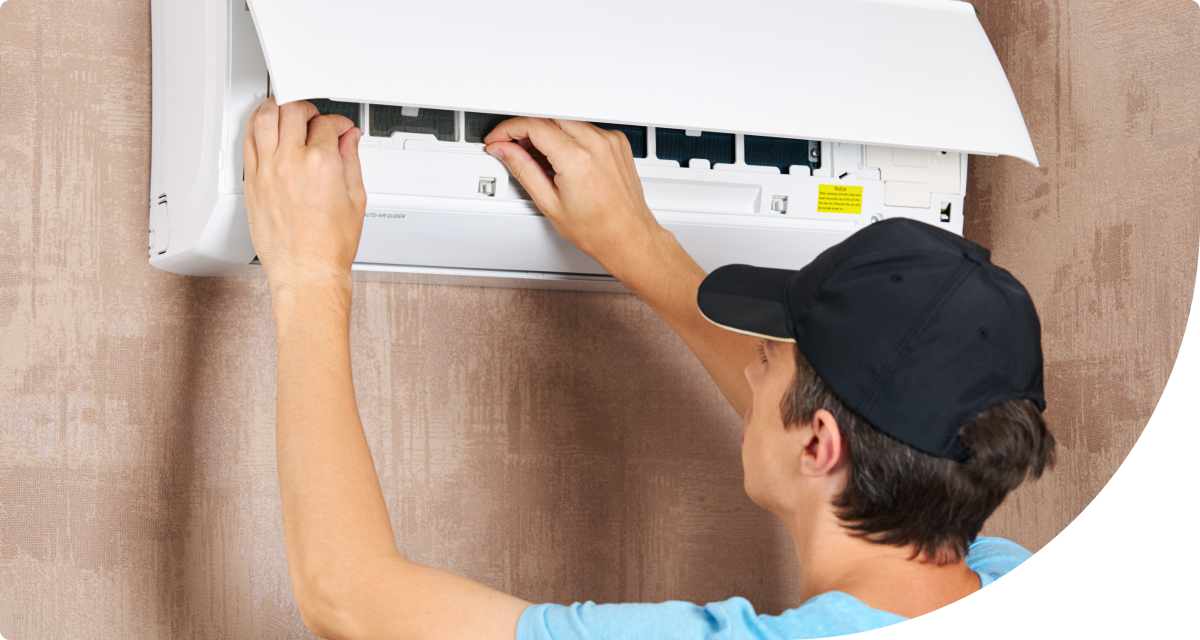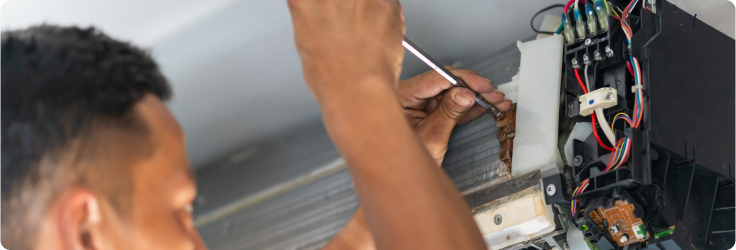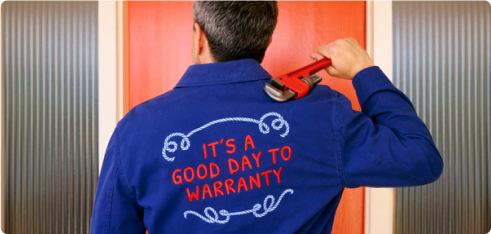Normal wear and tear
Running your AC year after year naturally takes a toll on the system. That’s called normal wear and tear, and it doesn’t mean you’ve done anything wrong. It just means you’re using your appliances like, well… a normal person.
The gentle whir of your air conditioner kicking on in the summer should be nothing more than peaceful background noise, and a comforting reminder that you’ve got a cool escape from the heat. But if you start noticing odd smells or other unusual behavior from your air conditioning system, it could be a sign that something’s not quite right.

The earlier you catch an air conditioner problem, the easier it usually is to fix. But while some issues can be handled with basic troubleshooting, others may need Expert insight—especially if you’re not sure of the cause.
As a benefit to select plans, enjoy real-time help from an HVAC Expert through American Home Shield® video chat. Talking to a live Expert on the AHS app makes solving many of your biggest AC questions simpler than ever.
You’ve done nothing but show your air conditioner love and appreciation. So when the airflow starts acting up, it can feel pretty confusing. What actually causes common problems with AC units?
Here are a few usual suspects behind an unreliable system:

Running your AC year after year naturally takes a toll on the system. That’s called normal wear and tear, and it doesn’t mean you’ve done anything wrong. It just means you’re using your appliances like, well… a normal person.

While your AC system might seem like it runs itself, there are a few regular maintenance tasks that help keep it in tip-top shape, like HVAC Tune-ups and replacing the air filters. Skip them, and you might be looking at a breakdown sooner than expected.

Most experts agree that the lifespan of an AC system is 10-15 years. If yours is in that range and starting to cause trouble, you may just be reaching the end of the road.
Since your system relies on electricity, it’s not unusual for it to run into electrical hiccups. These problems can range from minor to more serious—and they’re often tricky to diagnose without a Pro.
Even if the problems you’re experiencing aren’t uncommon, troubleshooting air conditioners is often a whole different ballgame.
Additional reading:
How Does an Air Conditioning System Work?
HVAC Components & Parts of an Air Conditioner System

If you’re experiencing trouble with your AC, it’s nothing to worry about. Take some time to identify the symptoms of the air conditioner problem you’re facing. Then, use our guide to troubleshoot your air conditioner: first identifying the underlying issue, and then taking steps to fix it.
If you try each troubleshooting step and aren’t seeing a change, it may be time to call in a Pro.
One of the most evident air conditioning problems is when your system won’t turn on at all.
Symptoms:
Troubleshooting:
Even if your AC isn’t completely dead, you may be noticing weaker air flow than normal. Here’s what could be up:
Symptoms:
Troubleshooting:
Your AC system has one job: keeping you cool. So when it starts blowing warm air, that means trouble below the surface.
Symptoms:
Troubleshooting:
With select AHS plans, video chat with a repair Expert in real time, at no additional cost to you. It’s our version of phoning a friend—if all your friends had an average of 20 years of home repair experience.

Your AC should keep things cool, but not too cool. Frozen coils are a step too far.
Symptoms:
Troubleshooting:
Standing water spells a problem for your AC unit. Here’s what to keep in mind:
Symptoms:
Troubleshooting:
Summer may leave you a little sweaty, but your AC ducts shouldn’t share your struggle. If you’re noticing condensation on your ductwork, it’s time to take action.
Symptoms:
Troubleshooting:
How to clean your air ducts:
There’s no fresher feeling than knowing when your HVAC hits the fan, your home warranty’s got you covered. Become an AHS member today and stop sweating the big (and small) stuff.

Moist air inevitably travels through your ducts, but that doesn’t mean it needs to leave its mark. If you notice mold in your HVAC ducts, here’s how to handle it.
Symptoms:
Troubleshooting:
Refrigerant is the lifeblood of your AC system. Leaking might indicate you’re dealing with serious damage behind the scenes.
Symptoms:
Troubleshooting:
Unfortunately, refrigerant leaks require a licensed HVAC Pro. You can help by noting symptoms and turning off your unit to prevent further damage.
AC systems should be experienced and not heard. This is how to troubleshoot unusual sounds.
Symptoms:
Troubleshooting:
If your AC system has a stench, it’s time to take action. But the exact action to take depends on the smell.
Symptoms:
Troubleshooting:
Creatures in your conditioner? That’s no fun.
Symptoms:
Troubleshooting:
If you haven’t gotten around to inspecting your air filters in a while, you may be in for an unfortunate surprise.
Symptoms:
Troubleshooting:
Replace your air filter. It’s quick, easy, and one of the most important maintenance steps you can take. Check it every 1–3 months, especially during heavy-use seasons.
Additional reading:
Blowing warm air
Frozen coils
Standing water in drain pan
Sweating air ducts
Mold in HVAC ducts
Foul odors
Pest problem
Dirty air filters
Sometimes, air conditioner problems aren’t fixable. You may find that even when you’ve tried every air conditioner troubleshooting tip, your system still isn’t functioning how it used to be. These are some signs that your AC trouble is too great to repair:
Most systems start to decline after this point, even with regular maintenance.
If you’re constantly calling for help, the costs might start to outweigh the benefits.
Your energy bills are suddenly sky-high
Poor efficiency could mean your unit is working overtime just to keep up, which could seriously affect your utility bills.
These are expensive to fix, and often signal serious internal problems. Plus, the EPA’s refrigerant recommendations have recently changed, meaning it might just make more sense to upgrade to a modern system.
This is one of the most expensive components to replace, and sometimes it makes more sense to start fresh.
If the strange symptoms never let up, it might indicate deeper damage.
Major damage or airflow blockages in your ducts can significantly affect your system's performance—and fixing them may not be worth the cost if your unit is already aging.
If you’re ready to stop pouring money into a system that’s on its way out, it might be time to start thinking about a replacement. The American Home Shield® New HVAC Program can offer savings on new, efficient systems, allowing you to upgrade your comfort with confidence.
Additional reading:
When to Replace Your A/C Unit
When It's Time to Book an Air Conditioning Service Appointment
HVAC System Upgrades, Tune-Ups, and Replacements
Your Guide to Buying a New AC Unit
Breakdowns might be inevitable, but regular upkeep can go a long way in keeping air conditioner problems at bay. The best kind of repair? One you never need—so taking good care of your system from the start is key to avoiding major issues down the line.
These are some of the key tenets of regular maintenance:
Scheduling a professional HVAC tune-up once or twice a year can help catch small issues before they become big, expensive problems for your AC unit. Between visits, keep an eye on performance and do a quick DIY inspection at the start of each season.
Check your air filter monthly and replace it every 1–3 months, depending on usage and indoor air conditions. When a filter gets nasty and clogged, it can strain your system and reduce your indoor air quality.
Your outdoor condenser unit needs room to breathe. Clear away leaves, branches, and dirt regularly, and make sure there’s at least two feet of clearance on all sides.
A clogged condensate drain can cause water to get backed up and your system to shut down in response. Pour a bit of vinegar or a gentle cleaning solution down the line every few months to keep things flowing.
Your ducts and vents should be largely free of dust, which reduces efficiency and spreads allergens. Vacuum vents regularly and consider professional duct cleaning if airflow seems off.

One list to cool them all.
Download our free HVAC Maintenance Checklist to stay on top of your routine.
No matter how diligent your maintenance or how thoroughly you tackle troubleshooting your air conditioner, every system has its limits. When the time comes to replace your unit, it helps to have a plan. That’s where the American Home Shield New HVAC Program comes in handy. With this replacement program, you can leverage our national buying power to save thousands* off national retail pricing on a new HVAC system, and make sure you’ve got an AC system that can keep up with the future.
AHS plans have expansive coverage for many of the major parts of your HVAC system, from the compressor to the evaporator coil. We’ve got your back when things break down—and we’re still in your corner when they don’t. That means video chat support when you have air conditioning problems, guidance when you’re ready to upgrade, and peace of mind all year long.
After all, keeping your cool shouldn’t be complicated.
AHS assumes no responsibility, and specifically disclaims all liability, for your use of any and all information contained herein.